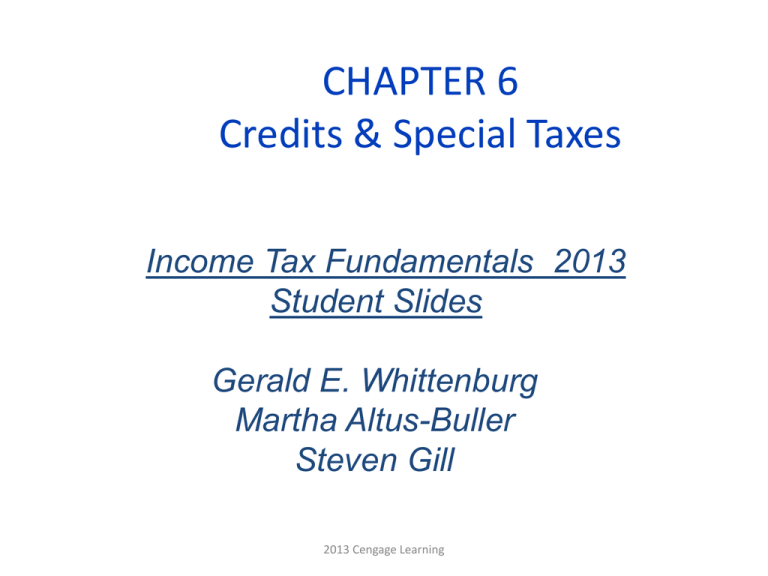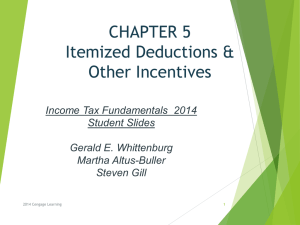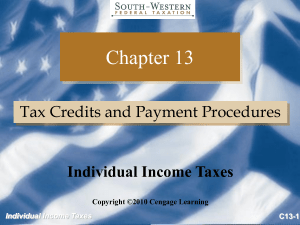CHAPTER 6 Credits & Special Taxes
advertisement

CHAPTER 6 Credits & Special Taxes Income Tax Fundamentals 2013 Student Slides Gerald E. Whittenburg Martha Altus-Buller Steven Gill 2013 Cengage Learning Credits and Deductions A credit is a direct reduction in tax liability ◦ Credits are used to target certain groups for tax benefit ◦ Provide equal benefit to all taxpayers A deduction is a reduction of taxable income ◦ Reduces tax liability in the amount of (deduction x tax rate) ◦ Provides more benefit to higher income taxpayers 2013 Cengage Learning Child Tax Credit Provides tax relief through a credit to taxpayers with children ◦ Credit for each child under age 17 claimed as a dependent and meeting definition of “qualifying child” Credit is $1,000 per child ◦ Credit begins phasing out when AGI > $110,000 (MFJ) AGI > $ 75,000 (HH, S) AGI > $ 55,000 (MFS) 2013 Cengage Learning Phased out $50 for each $1,000 (or part thereof) that AGI exceeds threshold Earned Income Credit (EIC) Refundable credit ◦ Serves as “negative” income tax ◦ Can get refund even if have no tax liability Taxpayer may get EIC, even without kids ◦ Taxpayer must be between ages 25 and 65 and not claimed as another taxpayer’s dependent ◦ “Disqualified income” (identified as certain type of investment income) must be less than $3,200 Taxpayer(s) with children can receive EIC ◦ If child meets definition of “qualifying child” ◦ Single or married taxpayers (MFJ only) ◦ Earned income meets certain guidelines 2013 Cengage Learning Child & Dependent Care Credit Gives tax relief to working parents who must provide childcare for dependents ◦ Dependent must be under age 13 or ◦ Spouse or dependent who cannot care for themselves If child’s parents are divorced, child need not be dependent of taxpayer claiming credit if he/she lives more than 50% of year with that parent Multiply qualifying care costs (see next slide) by an applicable percentage, based on AGI ◦ From 35% down to 20% ◦ Credit percentages found on Table 6.1 on page 6-5 2013 Cengage Learning American Opportunity Credit Provides tax relief for qualified higher education expenses ◦ Tuition, fees, books and course materials Available for each eligible student in first four years of college ◦ Eligible students are taxpayer, spouse or dependent ◦ Student must be at least 1/2 time for one term during tax year ◦ Student must not have felony drug conviction Credit = 100% of first $2,000 + (25% of the next $2,000) ◦ Maximum credit = $2,500 ◦ Phased out when AGI > certain levels (see page 6-9) ◦ 40% of it is refundable Note: This credit is the expanded and renamed ‘old’ HOPE credit 2013 Cengage Learning Lifetime Learning Credit (LLC) Provides tax relief for education expenses encourages taxpayers to take courses to acquire or improve job skills ◦ Tuition and fees only (not books) ◦ Can be used for less than ½ time attendance ◦ Not disqualified for felony drug conviction Credit = 20% of first $10,000 ◦ Maximum credit = $2,000 per year ◦ Lower AGI phase-outs than American Opportunity Credit ◦ May take credit in relation to undergraduate, graduate or professional courses ◦ No limit on number of years you may claim LLC 2013 Cengage Learning Adoption Credit IRS provides a credit as relief to taxpayers who pay adoption expenses Credit is amount spent up to $12,650 per adoption (not an annual amount) o o Adoption credit begins to phase out when AGI > $189,710 Different rules if pay expenses over more than one year or if foreign adoption or special needs child Qualified adoption expenses include court costs, legal fees, travel, etc. Unused credits can be carried over for up to five years 2013 Cengage Learning Overview of Major Energy Credits In 2012, two major credits designed to encourage individuals to utilize energyefficient products ° Plug-in Electric Vehicle Credit ° Credit for Residential Energy-Efficient Property (REEP) 2013 Cengage Learning Energy-Efficient Vehicles Credit Credit for purchase of hybrid gas-electric vehicles ° Amounts vary, based on combination of weight and kilowatt hour of traction battery capacity (between $2,500 - $7,500) ° Credit phases out for each car manufacturer when they hit 200,000 cars sold ° 10% credit up to $4,000 is allowed for cost of converting any motor vehicle into a qualified plug-in electric drive vehicle ° 10% credit up to $2,500 for electric drive low-speed vehicles, motorcycles and three-wheeled vehicles (except golf carts) Note: 10% credit set to expire 12/31/12, but may be extended by Congress 2013 Cengage Learning






